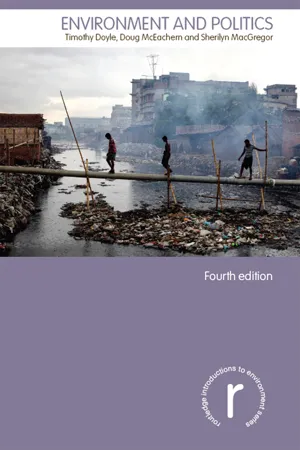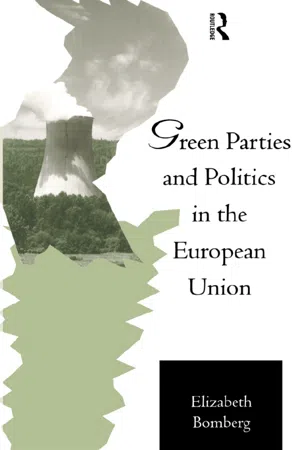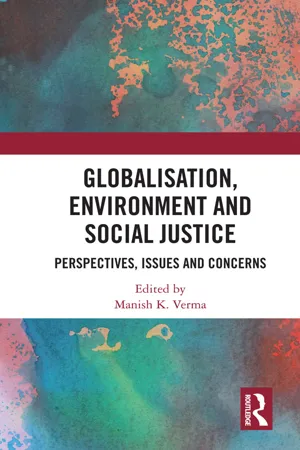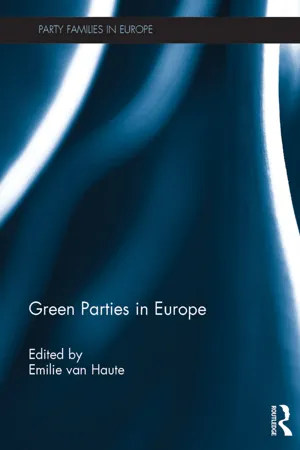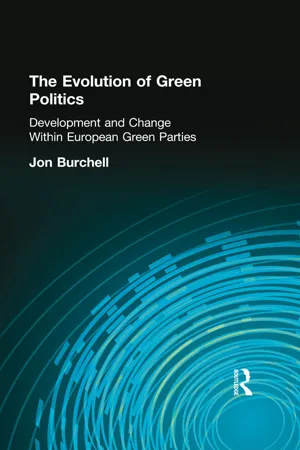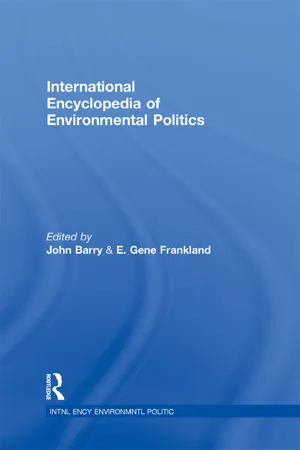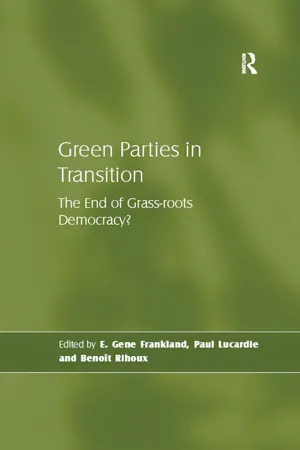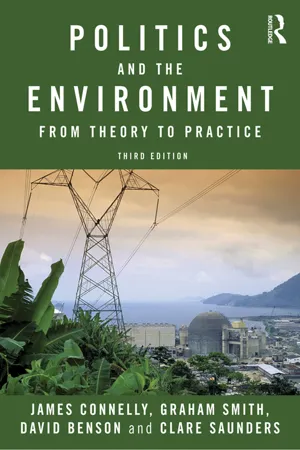Politics & International Relations
Green Party
The Green Party is a political party that prioritizes environmental sustainability, social justice, and grassroots democracy. It advocates for policies aimed at addressing climate change, promoting renewable energy, and protecting natural resources. The party also focuses on social issues such as healthcare, education, and income inequality, and often emphasizes nonviolent solutions to global conflicts.
Written by Perlego with AI-assistance
Related key terms
Related key terms
1 of 4
Related key terms
1 of 3
10 Key excerpts on "Green Party"
- eBook - ePub
- Derek Wall(Author)
- 2010(Publication Date)
- Between the Lines(Publisher)
Chapter 1Global green politics
The term ‘green politics’ was once synonymous with the German Greens, who have participated in governments for much of the last three decades. But Green parties have now gone global – from Kenya to Mongolia, Taiwan to Brazil. And green political activity encompasses non-electoral campaigns and direct-action techniques the world over.In 1983, 28 members of the German Green Party were elected to the West German parliament. Dressed informally in jeans, some of them brought in plants to place on their desks. Their colorful arrival contrasted with the suited members from the traditional parties.Their success marked the first entry into a national parliament of a group of greens. The German Greens were elected in 1983 on a platform with four key elements: ecology, social justice, peace and grassroots democracy.Green parties were born in the early 1970s, grew in the 1980s and green politics is now a global phenomenon. Green politics is first and foremost the politics of ecology; a campaign to preserve the planet from corporate greed, so we can act as good ancestors to future generations. However, green politics involves more than environmental concern.Ecology may be the first pillar of green politics but it is not the only one. Andrew Dobson, an English Green Party member and academic, has argued that green politics is a distinct political ideology. While much ink has been spilt defining the term ‘ideology’, Dobson argues that it is a set of political ideas rather than a single idea, even one as powerful as concern for the environment. He argues that a political ideology provides a map of reality, which helps to show its adherents how to understand the world. He also believes that ideologies demand the transformation of society. He uses the term ‘ecologism’ to distinguish green politics from simple ‘environmentalism’.The second pillar of green politics – social justice – is vital. Greens argue that environmental protection should not come at the expense of the poor or lead to inequality. This social justice element places greens on the left of the political spectrum. Greens argue, however, that the right-left spectrum is not the only dimension of politics, not least because there are many political parties that are committed to social justice but which fail to protect nature. - eBook - ePub
- Timothy Doyle, Doug McEachern, Sherilyn MacGregor(Authors)
- 2015(Publication Date)
- Routledge(Publisher)
The first green parties were formed in New Zealand and Tasmania in the early 1970s (Rainbow 1992). Over the past 40 years, thousands of Green Party candidates have been elected to offices at local, state/provincial, national/federal and international levels. The greens have had moderate success in the European parliament and they were the first to form an EU-wide political party. Since its founding in 2001, the Global Greens international network has operated to promote a Global Green Charter, deepen communication among green parties in 90 countries, and to facilitate action on global environmental matters (Global Greens 2006). In 2008, it adopted ‘21 Commitments for the 21st Century’ and in 2010 established the leadership role of Global Greens Secretariat (see Box 5.2). Green parties share a commitment to a common set of principles, known as the ‘ four pillars ’. They may be expressed in slightly different ways in different national contexts and languages, but the four traditionally listed (going back to the 1980s) principles are ecological wisdom, social justice, participatory democracy and non-violence. Some green parties have more recently added ‘respect for diversity’ and ‘sustainability’ as guiding values. In stark contrast to most traditional political parties, greens have tended to reject the practice of having one leader and many followers and operate through consensus decision-making processes. While some parties have recently moved to having leadership elections, for a long time greens had rotating spokespeople instead of a single leader. Even now, there is always a commitment to gender equality. The Green Party of England and Wales (GPEW), for example, has a policy that if the elected leader is a woman then the deputy leader must be a man (and vice versa). Note that this practice puts green parties ahead of ENGOs on the criteria of making deep political change - eBook - ePub
- Elizabeth Bomberg(Author)
- 2005(Publication Date)
- Routledge(Publisher)
1 Green politics in Europe
INTRODUCTION
This chapter places the Greens’ European policy in its wider political and historical context. It begins by outlining the key components and characteristics of ‘green politics’. Section II analyses the extent to which green politics and issues have permeated the politics and policies of the EU and EU Member States. Section III traces the emergence and development of ‘new social movements’, the precursors of the green movement and parties. Section IV examines how these movements developed into other political actors such as pressure groups or political parties. Using the development of the German Green Party as an example, this section introduces the key ideological and strategic characteristics shared by green parties in the EU.IINTRODUCING GREEN POLITICS
The terms ‘green politics’ and ‘greening’ have entered popular usage but are open to a wide variety of interpretations. The meaning of ‘green politics’ may be clarified by providing a brief outline of its key components.1 Green politics encompasses more than a concern for the environment. It includes both a unique set of values (content) and practices (process). Works by both political theorists and green activists suggest that the values, beliefs and practices of the green movement differ significantly from conventional politics. At its roots, green ideology encompasses a political, global, even spiritual critique of advanced industrial societies.Values
Whilst there are many different shades of green politics, a few shared basic components provide its foundation and ideological base. First, green ideology encompasses a wholesale critique of advanced industrial society. Rudolf Bahro (1986:11) summarises green ideology as a critique of the ‘dominant ideology’ which stresses economic growth and man’s domination of nature. By contrast, Greens adopt a holistic ‘ecocentric’ approach that is based on a concern about non-human nature and the whole eco-system rather than purely ‘human’ concerns (Hayward 1995:15).2 - eBook - ePub
Globalisation, Environment and Social Justice
Perspectives, Issues and Concerns
- Manish Verma, Manish K. Verma(Authors)
- 2018(Publication Date)
- Routledge India(Publisher)
12With such philosophy at its core, the first Green parties were founded during the early 1970s. The Values Party of New Zealand was the world’s first countrywide Green Party to contest parliamentary seats nationally in 1972. In 1973 Europe’s first Green Party, the UK’s Ecology Party, was established. The German Green Party has been an example of electoral success as one of the most significant parties winning 27 seats in the Bundestag in the 1983 federal elections in Germany. There have been more than 80 parties the world over constituted around the ideology of the Greens. The last two decades have seen the emergence of global greens.13 The Charter of the Greens is the foundational document. It draws upon the charters and constitutions of Green parties around the world, as well as some ideas from the Earth Charter and from the global gathering of Greens at Rio in 1992 (Global Greens Charter. 2012). Many European countries also developed ‘Green’ parties which constitute a good percentage of the total number of seats in the European parliament. The European Greens have always been committed to basic tenets of Green politics, such as environmental responsibility, individual freedom, inclusive democracy, diversity, social justice, gender equality, global sustainable development, and non-violence (European Union, http://europeangreens.eu , 2015). In the 1970s and 1980s the European Greens were generally sceptical of European political and economic integration, which was seen as contrary to environmental and social interests. In its 1984 program, the European Greens advocated the formation of an alternative Europe, which would be neutral and decentralised (Mol, A.P.J., Lauber, V. and Liefferink, J. 2000). In 1989, some member parties adopted a more parliamentary course and became more supportive of European integration. The program advocates the democratisation of Europe’s institutions. In their 1994 program, the Greens abandoned their principled opposition of European integration and began to propose pragmatic alternatives for the European Union’s policies and institutions.14 - eBook - ePub
- Emilie van Haute, Emilie van Haute(Authors)
- 2016(Publication Date)
- Routledge(Publisher)
Müller-Rommel and Poguntke, 1989 ). Furthermore, the specific influences on Green parties, considered immediately above, are not new. Green parties across Europe have always been partially divided by their differing levels of integration into their national political systems. Their origins have tended to be similar, but they have never been precisely the same in any two cases. In addition, of course, Greens have been exposed to the pressures of distinct national political cultures from their foundation. Indeed, to some extent, it can be said that each Green Party has grown out of its own particular nation-state, even as it has argued against the inadequacies of a solely national politics in the face of contemporary environmental and social crises. Party family approaches to ideological classification have always had to consider such factors and to make allowances for them.However, regarding the distinctiveness of Green Party ideology, the last 30 years have taken their toll. The thematic analysis above has shown that while all the parties advocate more direct forms of democratic participation, the state is tacitly accepted as the principal lever of social change, as is reflected in the texts as well as in the primarily electoral strategy of most Green parties. While the Greens under study here have a partially radical view of nature, they compromise and understand the environmental partly in utilitarian terms, even if they do so primarily to attract more votes. Their egalitarianism is still very much in view, but the parties do not overall approach discrimination against women and migrants in a radically systemic fashion. Finally, they say little of their opposition to economic growth, and they can scarcely be thought of as pacifist, often adopting positions compatible with ‘liberal humanitarianism’, even if the parties remain on the sceptical edge of this philosophy of military activity.In sum, Green parties have lost some of their radical edge. The aggregate Green Party ideology discovered in the analysis above has partially shifted away from the historical model of new politics, and one can no longer easily speak of them as ‘antiparty’ parties, neither in the organisational nor the ideological sense. This is very likely so because over a period of 30 years they all, including the more marginal amongst them, have become relatively established institutions seeking national political influence. All Green parties have undergone a greater or lesser degree of integration within the existing party system. Herein lies a potential challenge for future attempts to classify party families by ideology. If even the newest challenger group within European party systems has lost some of its ideological distinctiveness, and if this process of incorporation into the political mainstream continues, then this suggests that we must be prepared to adopt a more subtle approach than in the past. We must acknowledge that, in general, the gaps between party family ideologies are becoming less substantial than in past years. - eBook - ePub
The Evolution of Green Politics
Development and Change Within European Green Parties
- Jon Burchell(Author)
- 2014(Publication Date)
- Routledge(Publisher)
11 At the heart of all these classifications, however, lies what Young described as ‘the great divide’ (Young, 1992, p14). The basis of this ‘divide’ rests with the assumption that authentic or ‘true’ Green politics is understood as ‘deep’ and must be based upon ecocentric motivations. All other Green activity, by definition, is classed as ‘shallow’ (Barry, 1994, p370).GREEN PARTIES AS A ‘NEW ’ FORM OF POLITICAL CHALLENGEThe ideological roots of the European Green parties have thus been closely related to both the actions and development of a new form of social movement protest since the 1960s, and the emergence of an ecological critique of modern industrial society, which highlights the environmental dangers posed by continuous growth. Both dimensions are part of a process resulting in a ‘new’ form of political activism. Social movement literature highlights a challenge to traditional, established political channels which involves not only the emergence of new issues and issue priorities, but also encompasses a new style of social protest based upon greater participation and alternative forms of organization and action. Ecologism, too, represents a radical challenge to the established principles and priorities of modern industrial society: one in which the need to change our relationship with nature results in a significant alteration in societal values and concerns.Green parties have been identified as an emerging party political vehicle for many of these ideals and concepts. As such, analytical approaches to the study of Green parties have looked to both Green political theory and new social movement research for analytical tools. It is no surprise, therefore, to find that many of the ideas and concepts highlighted above are reflected in this analysis — both in terms of the central ideological commitments of these parties and the nature and style of party activism and organization. - eBook - ePub
- Brian Doherty(Author)
- 2005(Publication Date)
- Routledge(Publisher)
Each time after such disputes the green parties have recovered and while many of the traditional strategic issues remain divisive, the disputes have become much less intense. In part, this is due to a learning process. The intensity of strategic disputes reflected the period of party formation and development, when the apparent urgency of making a major breakthrough raised the stakes of every decision about the party’s future. It is perhaps depressing to point out that the problems are no less urgent, but that the greens have reduced their expectations. However, green parties are perhaps less central to the green project than they appeared in the 1980s. Then they were the ideological standard bearers for a broad new politics and it was hoped that their radicalism might infuse the left as a whole with new politics. Although this hope has not gone, particularly in countries such as France, where there is stronger resistance to neo-liberalism on the left, it now seems to be only one part of a much more multifarious green project, rather than its main plank.In the late 1990s the major influence on the development of the green parties was the entry of greens into national government in five western European states. Accepting a role in government was consistent with the strategic evolution analysed above, but for some this was the end of the greens as a party of the green movement. To assess whether this is the case it is necessary to examine the evidence from the greens’ experience in government to date.Greens in government
The first greens to enter a national government were the Finns in 1995, gaining the environmental ministry. The greens increased their vote and re-entered government in 1999 as part of a broad coalition of social democrats, conservatives and other parties. In Italy the greens were part of the Olive Tree coalition government led by the (ex-Communist) Party of the Democratic Left from 1996–2001; and in France, the greens entered government in 1997 gaining the environment ministry in the plural left coalition of the PS, Communists (PCF) and two other small left parties. The two Belgian green parties also joined a broad coalition government in 1999 gaining in particular from their campaign against the governing parties in the Dutroux scandal, concerning government corruption and incompetence in the case of a serial child murderer. - John Barry, E. Gene Frankland(Authors)
- 2014(Publication Date)
- Routledge(Publisher)
distributive justice. A shorthand way of expressing this is that green political theory extends the discourse of justice to cover: interspecies, intergenerational, international/global and social relations between humans and the non-human world and between humans. Barry (1999b) has listed some of the basic and novel features of green political theory. These include:- ’Overcoming the separation between ‘society’ and ‘environment’, (which includes extending environment to include the human, built environment)
- Appreciation of the biological embodiedness and ecological embeddedness of human beings and human society
- Viewing humans a species of natural being, with particular species-specific needs and characteristics
- Accepting both internal and external natural limits, those relating to the particular needs and vulnerable and dependent character of ‘human nature’, and external, ecological scarcity in terms of finite natural resources and fixed limits of the environment to absorb human-produced wastes
- As a critical mode of political theory, green political theory criticizes not just ‘economic growth’ but the dominant industrial model of ‘development’, ‘modernization’ and progress
- Claims that how we treat the environment is a moral issue, and not just a ‘technological’ or ‘economic’ one. This ranges from claims that the non-human world has intrinsic value, to the idea of animal rights
- Prescriptive aspects: restructuring social, economic and political institutions to produce a more ecologically sustainable world
- ‘Act local, think global’: ecological inter-connectedness and interdependence which transcends national boundaries.
- Futurity: time-frame of green social theory is expanded to include concern for future generations, i.e. concerns of intergenerational justice
- eBook - ePub
Green Parties in Transition
The End of Grass-roots Democracy?
- Paul Lucardie, E. Gene Frankland(Authors)
- 2016(Publication Date)
- Routledge(Publisher)
How to locate the Finnish Green League in the typology presented in the introductory chapter of this volume? The origin of the Greens is in new social movements, although many activists have a background in some established parties, mainly in the Communist Party or in the Liberal People’s Party. However, they had usually resigned from these parties, or became passive in them, before joining a new social movement and then the Greens. The ideology of the Greens is typically ‘thin’ or partial, although there may be different opinions about this. For some Greens, who obviously now form a minority, ecological problems are the only relevant problems. For the ecologists, nature does not ask how human beings organize their mutual relations and therefore these relations are of secondary importance. Most Greens, however, are interested in these relations, but they do not necessarily hold an ‘official’ opinion on all possible problems like the established parties.There are informal ties between the Greens and social movements. The Green League has an extremely low member–voter ratio. In my opinion this reflects the cadre party nature of the Greens. The leadership is a problematic affair. Today two members of the executive committee are MPs (Hassi and Pulliainen), some members are long-time activists (at least Kalle Könkkölä), but some are not very well-known even within the movement. In this respect, the Green League may be considered a cadre party.Selection of candidates for parliamentary elections is left to regional organizations. MPs, when elected, are not controlled by the party. There have been complaints that the parliamentary group controls the party executive committee. In cases of conflict, both the parliamentary group and the party leadership have been split. There seems to be a balance of power between the two. As to the main locus of power, I think that the answer would be similar as in the case of leadership.The formal basic units in the Greens are regional and local branches and ‘ideological’ societies. Regional branches correspond to electoral districts. The relation of the basic unit to the top is that of delegation. In a small party such as the Green League, many, if not most members participate ‘totally’ in politics. The party is funded mainly by the state; the importance of membership fee is minimal. The party is run mainly by volunteers, although there are also some professionals. The structure of the party described above has not - eBook - ePub
Politics and the Environment
From Theory to Practice
- James Connelly, Graham Smith, David Benson, Clare Saunders(Authors)
- 2012(Publication Date)
- Routledge(Publisher)
1998 ). Green parties embraced a series of institutional mechanisms attempting to promote grassroots democracy and prevent concentrated power. The principles of rotation and incompatibility were particularly important. Official posts were rotated with limited terms of service (usually one or two years) without re-election. Additionally the incompatibility rule prohibited the simultaneous holding of official positions, ensuring that parliamentary representatives could not also hold significant party positions (and vice versa). Collective leadership has been practised by regularly changing official party spokespersons (one male, one female) who are never parliamentary representatives. However, these and other similar mechanisms have eroded over time.In the light of its strong performance in the 1989 European elections, the issue of leadership became central to debates about how the Green Party of England and Wales should develop. A group of well-known public figures within the party launched Green 2000, a structural reform programme to streamline party organisation. High-profile members such as Jonathan Porritt and Sara Parkin believed that if the party was to capitalise on success it needed to adopt a more professional and realistic attitude to leadership, presentation and decision making. Recognisable and popular figures within the organisation should be charged with enhancing its image with the public. But for a sizeable number of party members, including many party activists, this violated deeply held beliefs, undermined grassroots influence and left power in the hands of a small executive. A very public rearguard action was fought that not only led to the resignation of some of the most prominent figures, but also declining membership. This acrimonious infighting contributed to the abysmal showing at the 1992 general election and although structural changes have taken place, it has taken the party a long time to recover.9
Index pages curate the most relevant extracts from our library of academic textbooks. They’ve been created using an in-house natural language model (NLM), each adding context and meaning to key research topics.
Explore more topic indexes
Explore more topic indexes
1 of 6
Explore more topic indexes
1 of 4

